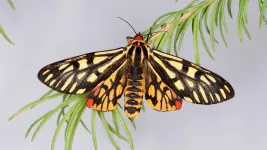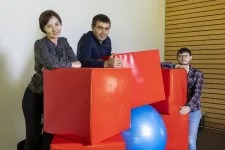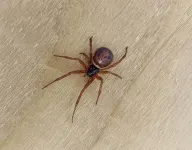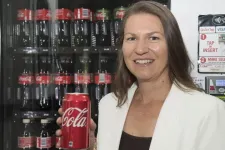(Press-News.org) MAY 26, 2021 -- Researchers from UTSA, the University of Central Florida (UCF), the Air Force Research Laboratory (AFRL) and SRI International have developed a new method that improves how artificial intelligence learns to see.
Led by Sumit Jha, professor in the Department of Computer Science at UTSA, the team has changed the conventional approach employed in explaining machine learning decisions that relies on a single injection of noise into the input layer of a neural network.
The team shows that adding noise--also known as pixilation--along multiple layers of a network provides a more robust representation of an image that's recognized by the AI and creates more robust explanations for AI decisions. This work aids in the development of what's been called "explainable AI" which seeks to enable high-assurance applications of AI such as medical imaging and autonomous driving.
"It's about injecting noise into every layer," Jha said. "The network is now forced to learn a more robust representation of the input in all of its internal layers. If every layer experiences more perturbations in every training, then the image representation will be more robust and you won't see the AI fail just because you change a few pixels of the input image."
Computer vision--the ability to recognize images--has many business applications. Computer vision can better identify areas of concern in the livers and brains of cancer patients. This type of machine learning can also be employed in many other industries. Manufacturers can use it to detect defection rates, drones can use it to help detect pipeline leaks, and agriculturists have begun using it to spot early signs of crop disease to improve their yields.
Through deep learning, a computer is trained to perform behaviors, such as recognizing speech, identifying images or making predictions. Instead of organizing data to run through set equations, deep learning works within basic parameters about a data set and trains the computer to learn on its own by recognizing patterns using many layers of processing.
The team's work, led by Jha, is a major advancement to previous work he's conducted in this field. In a 2019 paper presented at the AI Safety workshop co-located with that year's International Joint Conference on Artificial Intelligence (IJCAI), Jha, his students and colleagues from the Oak Ridge National Laboratory demonstrated how poor conditions in nature can lead to dangerous neural network performance. A computer vision system was asked to recognize a minivan on a road, and did so correctly. His team then added a small amount of fog and posed the same query again to the network: the AI identified the minivan as a fountain. As a result, their paper was a best paper candidate.
In most models that rely on neural ordinary differential equations (ODEs), a machine is trained with one input through one network, and then spreads through the hidden layers to create one response in the output layer. This team of UTSA, UCF, AFRL and SRI researchers use a more dynamic approach known as a stochastic differential equations (SDEs). Exploiting the connection between dynamical systems to show that neural SDEs lead to less noisy, visually sharper, and quantitatively robust attributions than those computed using neural ODEs.
The SDE approach learns not just from one image but from a set of nearby images due to the injection of the noise in multiple layers of the neural network. As more noise is injected, the machine will learn evolving approaches and find better ways to make explanations or attributions simply because the model created at the onset is based on evolving characteristics and/or the conditions of the image. It's an improvement on several other attribution approaches including saliency maps and integrated gradients.
Jha's new research is described in the paper "On Smoother Attributions using Neural Stochastic Differential Equations." Fellow contributors to this novel approach include UCF's Richard Ewetz, AFRL's Alvaro Velazquez and SRI's Sumit Jha. The lab is funded by the Defense Advanced Research Projects Agency, the Office of Naval Research and the National Science Foundation. Their research will be presented at the 2021 IJCAI, a conference with about a 14% acceptance rate for submissions. Past presenters at this highly selective conference have included Facebook and Google.
"I am delighted to share the fantastic news that our paper on explainable AI has just been accepted at IJCAI," Jha added. "This is a big opportunity for UTSA to be part of the global conversation on how a machine sees."
INFORMATION:
The Menetries' tiger moth (Arctia menetriesii) is one of the rarest and most poorly studied Palaearctic moth species. Even though its adult individuals are large and brightly coloured, they are difficult to spot, because they aren't attracted to light, they're not active at night, and they fly reluctantly. Currently, the species only inhabits two countries - Finland and the Russian Federation, and is included in the Red Lists of both, as Data Deficient in the former and Vulnerable in the latter.
For 13 years, researcher Evgeny Koshkin of the Institute of Water and Ecology Problems of the Far ...
Men aged 65 and over should monitor their sleep patterns and seek medical advice after a warning from Flinders University experts that disrupted slumber can be linked to cognitive dysfunction.
In a new article published in the Journal of Sleep Research, the Adelaide Institute for Sleep Health research group studied a group of 477 middle-aged and older men's attention and processing speed in relation to their sleep.
The participants from the Florey Adelaide Male Ageing Study undertook cognitive testing and a successful sleep study.
"Less deep sleep and more light sleep is related to slower responses on cognitive function tests," says lead author Jesse Parker. ...
To really appreciate what a team of researchers led by Maksym Kovalenko and Maryna Bodnarchuk has achieved, it is best to start with something mundane: Crystals of table salt (also known as rock salt) are familiar to anyone who has ever had to spice up an overtly bland lunch. Sodium chloride - NaCl in chemical terms - is the name of the helpful chemical; it consists of positively charged sodium ions (Na+) and negatively charged chloride ions (Cl-). You can imagine the ions as beads that strongly attract each other forming densely packed and rigid crystals like the ...
Scientists at Nanyang Technological University, Singapore (NTU Singapore) have developed a new biomaterial made entirely from discarded bullfrog skin and fish scales that could help in bone repair.
The porous biomaterial, which contains the same compounds that are predominant in bones, acts as a scaffold for bone-forming cells to adhere to and multiply, leading to the formation of new bone.
Through laboratory experiments, the NTU Singapore team found that human bone-forming cells seeded onto the biomaterial scaffold successfully attached themselves and started multiplying - a sign of growth. They also found that the risk of the biomaterial triggering an inflammatory response is low.
Such a scaffold could be used to help with the regeneration of ...
The parents of children with rare diseases face exceptional circumstances which influence their role as parents. Sometimes, the role of caregivers is added to that of parents. On other occasions, especially with the most serious cases, the former becomes more prominent than the latter. There are also cases in which both roles coexist separately, allowing them to be parents and caregivers in equal measure. However, whichever group they belong to, they need trust and to overcome fear in order to live their experience without overwhelming anxiety.
This is one of the findings of an open-access study published in the International Journal of Environmental ...
NUI Galway study confirms that the Noble False Widow spider does have public health implications
Research team have established a DNA database to allow clinicians dealing with cases to confirm the species identity using genetic analysis
Epidemiology of bites reveals that almost all bites occurred in and around the home, and 88% of bites occurred when the victim was either asleep in bed or when the spider was trapped in clothing
In parts of Ireland and Britain, the False Widow spider has become one of the most common species of spiders found in and around urban habitats
A team of scientists from NUI Galway have published a new study showing that Noble False Widow spiders ...
Eating habits amongst the young changed during the lockdown imposed due to COVID-19 and worsened in the case of those belonging to socioeconomically disadvantaged groups. These are the chief findings of an open access study published in specialist journal Nutrients, headed by researchers Alícia Aguilar Martínez, of the Universitat Oberta de Catalunya, and Marina Bosque Prous, of the UOC and UManresa, as part of the DESKcohort project of the interuniversity Epidemiology and Public Health research group GRESP.
The study, of 303 Catalan young people aged between 12 and 18, sought to establish how this age group's diet had changed from March to May 2020, in terms of both eating behaviours and the products consumed. The goal was to collect data to ascertain ...
For years, food producers who make lightly preserved, ready-to-eat food have had to follow a set of guidelines to stop growth of Clostridium botulinum bacteria and production of a strong neurotoxin. The toxin can cause a serious illness called botulism.
For refrigerated products, the guidelines for controlling Clostridium botulinum indicate that the water contained in the products should have a salt content of at least 3.5%. Unfortunately, this hampers efforts to develop salt-reduced products, even though such products would benefit public health, as most consumers eat more salt than recommended.
If food producers want to launch products that contain e.g. less salt, they have had to conduct laboratory experiments to document ...
Current neural network algorithms produce impressive results that help solve an incredible number of problems. However, the electronic devices used to run these algorithms still require too much processing power. These artificial intelligence (AI) systems simply cannot compete with an actual brain when it comes to processing sensory information or interactions with the environment in real time.
Neuromorphic chip detects high-frequency oscillations
Neuromorphic engineering is a promising new approach that bridges the gap between artificial and natural intelligence. An interdisciplinary research team at the University of Zurich, the ETH Zurich, and the ...
What keeps consumers hooked on high sugar soft drink? Advertising, of course. But why are some consumers more adept at ignoring these cues than others?
A new study from Flinders University, published in Appetite, found participants with an automatic bias towards soft drinks - or difficulty resisting sweet drinks compared to non-sweetened control beverages (e.g., water) - were more responsive to the ads than those without these tendencies.
The Australian study compared the ability of 127 university-age students (18-25 year olds) to withstand or succumb to the urge to reach for a soft drink when viewing television advertisements.
"Perhaps, then, we can start targeting people who show these ...



